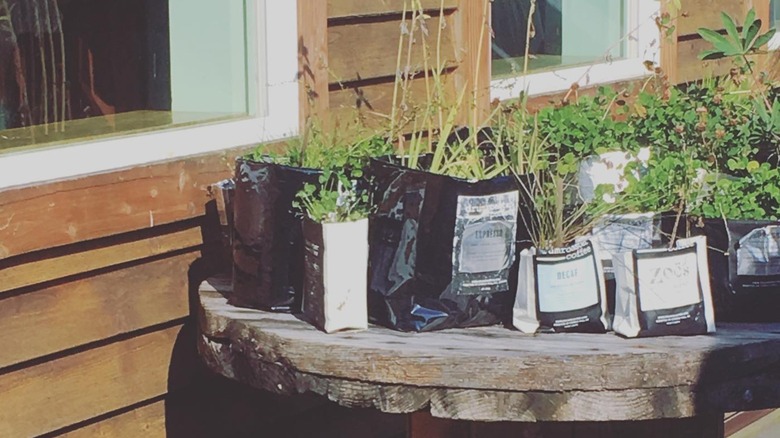We may receive a commission on purchases made from links.
If you brew coffee at home, chances are you’ve probably thrown away countless coffee bags. Ground and whole bean coffees generally come in sturdy bags designed to seal in flavor and aroma while keeping moisture out. Typically, these bags are made with layers of aluminum, paper, and various food-grade plastics to keep the elements out while still being aesthetically pleasing. This also makes most coffee bags non-biodegradable — a property that can be exploited by reusing them as planters for your tomato seedlings.
Because they are so sturdy, coffee bags easily double up as flexible little pots for young plants, small flowers, herbs, and succulents. For small plants, 16 and 32-ounce coffee bags work well, and coffee labels, in addition to being informative, are usually aesthetically pleasing, adding a quirky feel to these coffee bag planters. These bags can also be great for an indoor herb garden with some careful planning to ensure the plants get sufficient light, but are also sturdy enough to withstand an outdoor garden.
Since storing coffee beans in the bag they came in isn’t ideal, you should transfer them to an airtight container. Wash out the coffee bag and let it dry before punching some holes in the bottom to ensure water won’t stagnate in the bag once your plant is all set up. Place a small tray under the bag to catch any runoff, and roll down the top of the bag to make the top stable. You can also trim the top of the bag a little to help size it to your requirements, and then fill it with soil and your tomato seedlings or plants of choice. When you water the plant, check to ensure it drains well through the holes in the bag, otherwise, you risk water collecting and causing root rot.
All the ways you can use coffee bags (and even coffee grounds) in your garden
You can also make hanging planters from your upcycled coffee bags by first fashioning the bag into a pot as described, and then making some additional holes in the top for hanging. However, to ensure the bag doesn’t tear, you’ll have to install a metal ring in the openings used for hanging. For a cleaner look, use a tool like this Paxcoo Grommet Tool Kit and a sturdy rope or wire to hang the planters. Make sure to place a tray underneath to catch drained water, or simply use a plant mister to keep your green friends moist.
Resealable coffee bags can find several additional uses around the garden, from a container to store seeds and other perishable materials, to using them as organizers for small garden tools. These waterproof bags can even be used to line flower beds or anywhere else where you want to keep dry and wet areas separate.
If you’ve got coffee bags, you’re likely generating used coffee grounds as well. Composting is the best way to use this nitrogen-rich food waste to provide nutrition to your garden and even potentially ward off fungal pests for tomatoes. Simply ensure that no more than a quarter of your compost material is coffee grounds. A light sprinkling of coffee grounds on top of your soil can also provide nutrients for plants. However, since coffee grounds are slightly acidic, check whether the plants you are using them for will benefit from them or not, and keep them away from seedlings, as the caffeine can inhibit growth.






